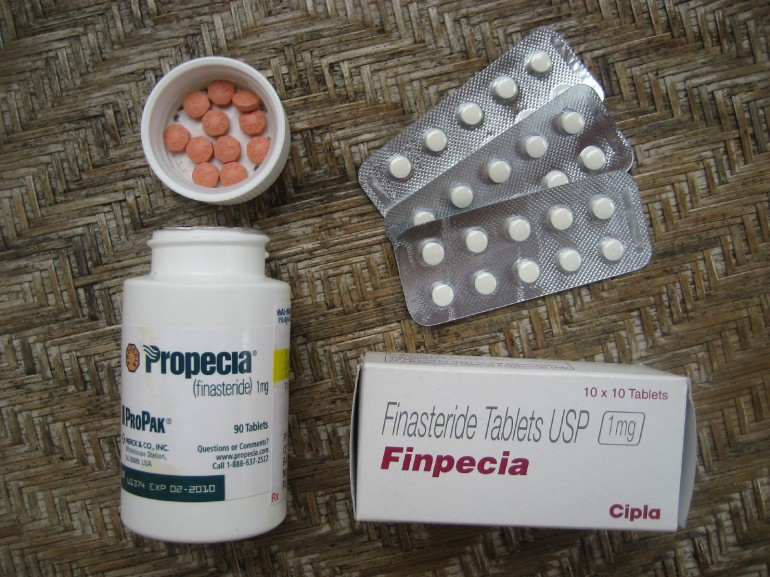Removal of skin tumors: advantages and disadvantages of modern techniques
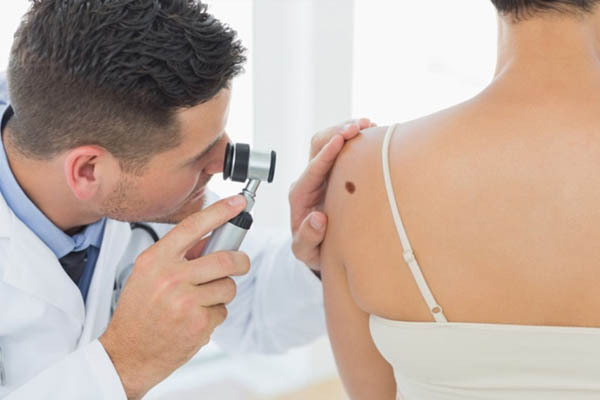 Removal of skin tumors is a series of special procedures, the implementation of which is in the competence of such doctors as a dermatologist and oncologist.Cutaneous neoplasms are a group of diseases that are a quantitative growth of skin structures with qualitatively altered pathological cells, they can be limited and enlarged in size.Often such a problem becomes not only a cosmetic defect, but also has clear prerequisites for disposal, being potentially hazardous to health.The procedure for removal should always be preceded by an accurate diagnosis, the task of which is to differentiate the malignant tumor from benign.
Removal of skin tumors is a series of special procedures, the implementation of which is in the competence of such doctors as a dermatologist and oncologist.Cutaneous neoplasms are a group of diseases that are a quantitative growth of skin structures with qualitatively altered pathological cells, they can be limited and enlarged in size.Often such a problem becomes not only a cosmetic defect, but also has clear prerequisites for disposal, being potentially hazardous to health.The procedure for removal should always be preceded by an accurate diagnosis, the task of which is to differentiate the malignant tumor from benign.
Indications for removal of tumors
dermatologist can remove the following types of benign skin lesions:
- warts;
- papillomas;
- nevi;
- cutaneous horn;
- keratomas;Genital warts;
- ;
- atheroma;
- molluscum contagiosum;
- to xantelism.
radical removal can be performed for the following indications:
- medical,
- cosmetic
Medical - readings due to the presence of such pathologies:
- cutaneous pathologies of viral origin, which is not typically self-healing( Molluscum contagiosum, pointed condylomas, warts);
- growths on the skin, located in frequent injury sites( face, underarm area, hands, feet) or constant rubbing of clothing.
Cosmetic indications are the removal of keratomas, moles and papillomas, which are an aesthetic defect.Please note: located in the area of the feet and palms of the birthmark are advised by the doctors to remove the malignant form in order to prevent their degeneration into melanoma.
Contraindications to remove tumors
There are a number of conditions which are not allowed to carry out intervention on the elements of the skin. These are:
- allergic reaction;
- hypertensive crisis;
- fever;
- ARD;
- herpes( exacerbation stage);
- some cases of malignant growths.
Methods for removal of skin lesions
Today in dermatology apply a variety of methods for removal.Each of them has its advantages and limitations.Let's consider the main ones.Removal of tumors
laser
Laser photocoagulation or lazerodestruktsiya - the removal laser neoplasms.A special beam destroys the skin element by burning.Usually a CO2 laser or a semiconductor laser is used. The advantages of laser removal technology include:
-
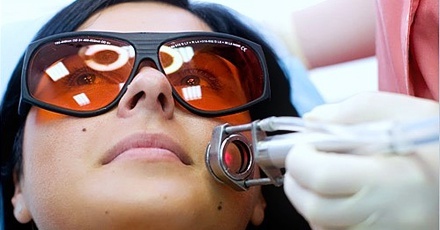 painless;
painless; - no injuries to surrounding tissues;
- local anesthesia;
- is bloodless;
- rapid epithelialization of the procedure site;
- high efficiency;
- is not necessary for a stationary stay.
By laser disadvantages scar that can remain after the procedure at the site of deletion, but this is true only for subcutaneous elements.Laser removal of neoplasms is the most preferred technology, because it can be used for almost all types of skin defects.Depending on the situation, the doctor can perform the removal in several modes: evaporation of tissues, excision or coagulation.Thus, the laser is used both as a scalpel and as a tool for cauterizing the removal site, which prevents bleeding, by coagulation of the vessels.The laser is most often used to remove neoplasms on the face, because it allows you to carry out the procedure very accurately and "jewelry".
Surgical removal of neoplasms
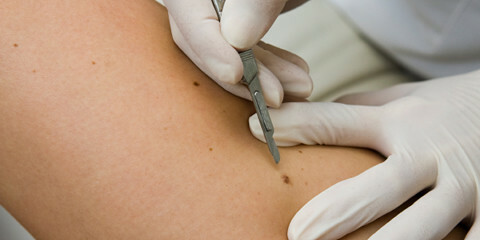 The removal of pathological cutaneous elements by surgical method is a classic technique that involves the use of a scalpel and the subsequent application of a suture after excision.Direct indications for removal of skin tumors by surgical method are large sizes and doubts about its good quality. The advantages of the surgical method can be called:
The removal of pathological cutaneous elements by surgical method is a classic technique that involves the use of a scalpel and the subsequent application of a suture after excision.Direct indications for removal of skin tumors by surgical method are large sizes and doubts about its good quality. The advantages of the surgical method can be called:
- radical;
- minimum risk of re-growth of the element;
- availability.
The disadvantage of the surgical method lies only in the presence of postoperative scars, which have a non-aesthetic appearance and the necessary post-operative care for the suture.
Cryodestruction
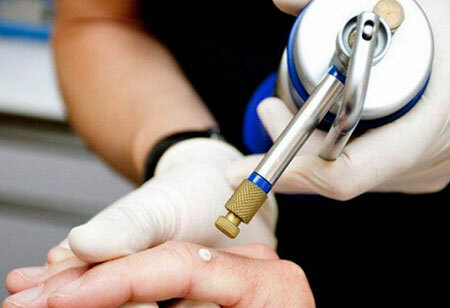 This is a method based on the use of low temperatures for removal of tumors. Local exposure freezing on pathologically altered tissues in dermatology occurs in several ways:
This is a method based on the use of low temperatures for removal of tumors. Local exposure freezing on pathologically altered tissues in dermatology occurs in several ways:
- Applicator cooling( made of metal);
- spraying;
- application with cotton swab.
For the purpose of destroying skin lesions by cryodestruction, usually liquid nitrogen is used.Note: is most often used to eliminate elements that do not protrude above the skin surface( moles, pigment spots, keratomas). The technology itself has such advantages:
- no gross scars on the skin after the procedure;
- painless healing process;
- no need for bandaging.
Disadvantages of the procedure:
- need to be repeated, especially with regard to warts;
- is a rare application for removing neoplasms on the face;
- longer process of rejection of a crust in a place of procedure in comparison with the laser, for example;
- inability to control the depth of impact;
- has a risk of burning surrounding tissues;
- high possibility of scarring.
Actually, cryodestruction is an effective technique, but its effectiveness and absence of complications directly depends on the capabilities of the equipment, practical experience and the level of the doctor's qualification.
Thermocoagulation
This technology also assumes the impact of temperature on the pathological element, but unlike cryodestruction, not low, but high.To do this, use a metal red-hot loop, which effectively burns the tissue. 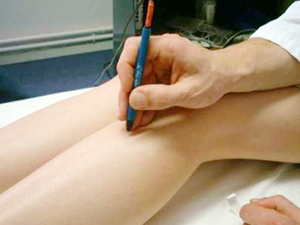 Thermocoagulation can be performed in such techniques:
Thermocoagulation can be performed in such techniques:
- thermal cautery;
- cautery;
- electrothermocaustic.
Advantages of this method of removing skin lesions:
- Affordable cost;
- bloodlessness;
- no noticeable scar;
- takes a little time.
Complications after thermocoagulation may occur if the technician incorrectly performed it and made mistakes.In particular, there may be pain, redness and itching at the site of exposure.
Diathermic coagulation removal
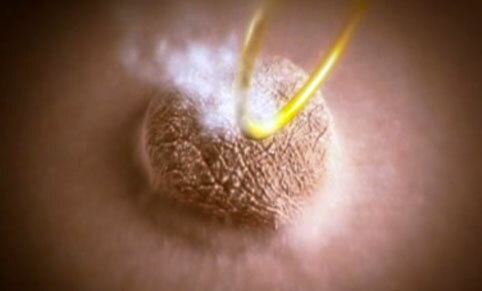 This technology involves the use of high-frequency electric alternating current, which is characterized by high strength and low voltage.These parameters allow carrying out the destruction of pathological tissues in the optimal regime.The main difference between this technique and thermocoagulation is that the electrode does not undergo heating. The removal of skin lesions in this case is carried out in two versions:
This technology involves the use of high-frequency electric alternating current, which is characterized by high strength and low voltage.These parameters allow carrying out the destruction of pathological tissues in the optimal regime.The main difference between this technique and thermocoagulation is that the electrode does not undergo heating. The removal of skin lesions in this case is carried out in two versions:
- contactless removal, in which there is no contact between the skin of the patient and the electrode, and the current passes through the air( plasmocoagulation, SPRAY-coagulation);
- contact removal, involving the touch of the electrode to the skin element( electrocautery, electrical section).
Important Advantages of Diathermocoagulation:
- bloodlessness;
- precision scalpel;
- no need to re-conduct;
- the presence of the most thin electrode( like hair) allows even electroepilation;
- during the procedure, you can control the depth of the current.
Sometimes, after removal of diathermocoagulation, a pigmented spot may remain, but it soon disappears.This technique is used as often as a laser.Such a demand is due to a large number of advantages and a minimum of shortcomings. Electrocoagulation is used to remove neoplasms in the form of papillomas and moles in any places, and especially - on the face.
Radiosurgery
It is the most nontraumatic procedure, which is based on the use of high-frequency waves to remove neoplasms.This method is used even if necessary to remove an element located in a hard-to-reach place( mucous membrane of the mouth, eyelids). Advantages of radio wave surgery include:
-
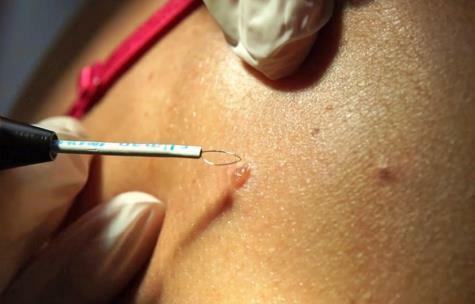 complete absence of pain during the procedure;
complete absence of pain during the procedure; - no bleeding after removal;
- does not leave a trace at the removal site;
- no risk of secondary infection;
- healthy areas remain intact;
- fast healing process;
- can be used to eliminate warts from papillomas and moles.
Important : is also worth mentioning that one of the main differences in radiosurgery from the laser, for example, and other techniques is the ability to perform a histological examination of the removed tissues for their structure and good quality.
Chemical destruction
It involves the use of chemicals to destroy pathological structures on the skin. In practice, the following agents are used:
- nitric acid;
- 5-fluorouracil;
- salicylic acid;
- podophyllin;
- trichloroacetic acid.
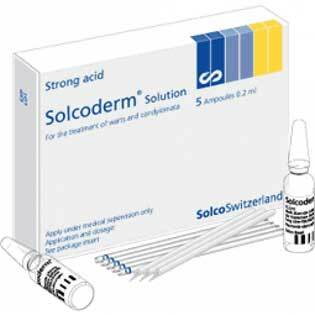 Among the above acids and cytotoxic drugs, Solcoderm has been widely used today, which is based on acetic acid and is used to remove nevuses, warts and papillomas.This solution has a mummifying and cauterizing effect in contact with benign skin tumors.An important drawback of chemical destruction is the inability to control the depth of destruction. Note: in some situations, a doctor can suggest a combination of methods that will help achieve maximum effect.For example, the surgical method + laser allows to remove the tumor on the skin and laser treatment of the excision site, without the need for suturing.The use of thermocoagulation and cryodestruction provides painless and highly effective removal procedures
Among the above acids and cytotoxic drugs, Solcoderm has been widely used today, which is based on acetic acid and is used to remove nevuses, warts and papillomas.This solution has a mummifying and cauterizing effect in contact with benign skin tumors.An important drawback of chemical destruction is the inability to control the depth of destruction. Note: in some situations, a doctor can suggest a combination of methods that will help achieve maximum effect.For example, the surgical method + laser allows to remove the tumor on the skin and laser treatment of the excision site, without the need for suturing.The use of thermocoagulation and cryodestruction provides painless and highly effective removal procedures
Frequently Asked Questions regarding the removal of tumors
What is the best method for removing neoplasms on the skin?
It is important that the attending physician sees a line separating the difference between the aesthetic result of the procedure and its effectiveness.This means that the wider and deeper the tumor is removed, the lower the likelihood of a relapse.Conversely, minimal surface removal is always an ideal cosmetic result, rapid epithelization, absence of a scar, but a high risk of developing a new neoplasm at this site.On the removal of warts, it is worth saying that after the procedure, the likelihood of their recurrence persists.This is justified, to a greater extent, not by errors during the procedure, but because warts are a pathology of viral origin.Removal in this case is the only way to deal with them, because others have not yet been invented.Birthmarks are important to remove completely, because partial elimination is a trauma that can become the trigger mechanism of degeneration into malignant melanoma.Note: , if there is even a small doubt about the good quality of education, the doctor must send the patient to the oncologist. On the question of which of the methods of removal of neoplasms is still better - there is no specific answer.Everything depends on the experience of the doctor, his skills, practice, the type of tumor, accompanying pathologies.
Will it hurt?
Qualitative anesthesia will successfully use any of the above described method.It can be both an anesthetic cream, and an injection of a special drug. No need for anesthesia in the case of:
- cryodestruction,
- removal of small papillomas,
- using "Solcoderm".
What will happen after the deletion?
Cryodestruction assumes frostbite of the neoplasm due to which a bubble forms in its place, which then shrinks into a crust.After surgical excision it is necessary to apply a bandage, the sutures are removed for 5-7 days.In the case of other ways to remove tumors, the crust is formed almost immediately after the procedure.Healing takes from 2-3 days to 2-3 weeks, all depends on the amount of intervention. Important : when using any method of deletion, it is necessary to adhere to the main rule - not to wet the procedure area. Viktorova Julia, obstetrician-gynecologist doctor



